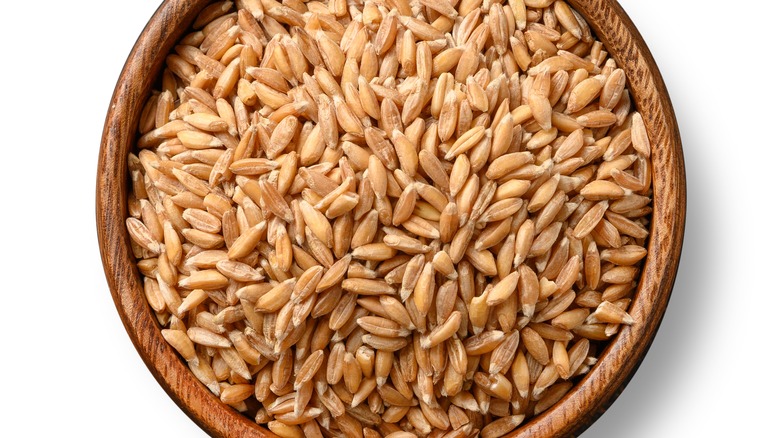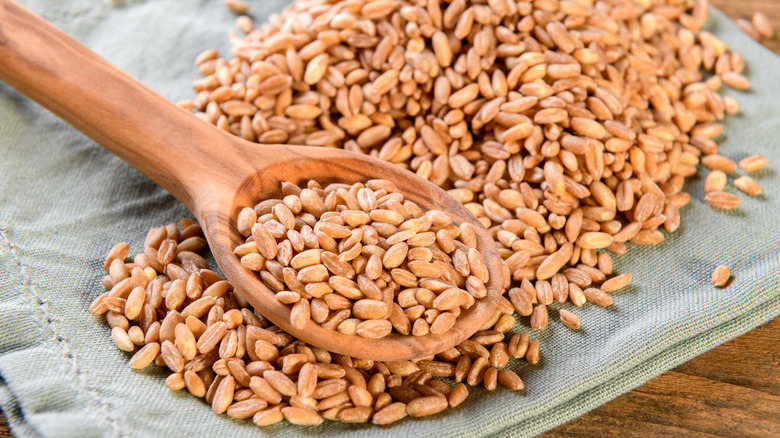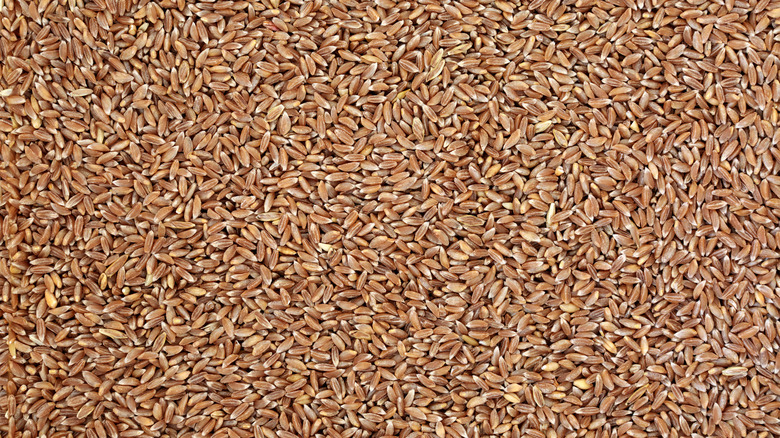What Is Farro, And What Does It Taste Like?
One of the healthy foods that everyone pronounces wrong, farro (pronounced "fahr-oh) is a whole-grain with plenty of protein, fiber, magnesium, zinc, and B vitamins. Typically used as a replacement for rice, quinoa, barley, or pasta, it is often added to soups or salads. Debuting in recipes like ancient grain pilaf, sautéed fish with fresh herb butter, and The Cheesecake Factory's Tuscan Chicken, the seemingly up-and-coming grain was likely first used in the Fertile Crescent nearly 10,000 years ago. The grain was a source of fuel for hungry Roman soldiers and has also been discovered in the graves of Egyptian kings.
Maria Speck, who wrote a book on whole-grain recipes, shared with NPR that farro's popularity in the U.S. likely "got ignited by our passion for Italian food." While the grain was first discovered in Mesopotamia, it is now grown in Tuscany, Umbria, Marche, and Abruzzo. Farro consists of three types of grains: Farro piccolo (einkorn), farro medio (emmer), and farro grande (spelt). The U.S. prefers using emmer, a brown, tough, nutty grain that is well-liked by Italians. Einkorn, the oldest of the three types, is an uncommon find that is yellow, sweet, nutty, and an excellent addition to desserts such as banana bread, cookies, or muffins. Like Einkorn, spelt offers a sweet, nutty taste, but is a mild brown color and has less protein but more gluten. Spelt makes a good addition to dishes like risotto or whole-grain pancakes.
Shopping for and cooking with farro
When searching for farro, you may come across each grain's subsequent Latin name: Triticum monococcum (einkorn), Triticum dicoccum (emmer), and Triticum Spelta (spelt). There are also several types of farro to shop for. Whole farro contains all of the grain's beneficial properties: protein, fiber, magnesium, zinc, and B vitamins. Semi-pearled farro takes away some of the bran, but still has fiber, while pearled farro is quicker to cook, but lacks bran. Cynthia Harriman, who helps run The Whole Grains Council, told NPR, "There is indeed a lot of confusion about farro." However, once you've got the basics down, you may become like some U.S. chefs, who, over the past several decades, have started to love using farro.
Reed Hearon used farro at San Francisco's Black Cat restaurant. He told SFGATE, "It has a real affinity for meat juices or broth." Paul Bertolli, who was a chef at San Francisco's Oliveto, said he used farro with game birds or in earthy salads. The late chef Judy Rodgers, who helmed San Francisco's Zuni Café, said she made farrotto with dried porcini. The dish is similar to risotto, but uses farro, onions, mushrooms (porcini), and chicken stock, a broth made from chicken bones. Hugh Acheson, a judge on Top Chef, shared a seared salmon with parsley farro recipe with People. For this creation, Acheson uses farro, olive oil, a minced shallot, salt, pepper, parsley, and salmon fillets.
Farro's growing popularity
While the general consensus is that farro has a nutty taste, its taste is also typically compared to brown rice. On a "Farro OBSESSED" Reddit thread, one poster commented: "Are any of you on the farro train? I'm not sure why the obsession but I could eat it (and do sometimes) by the spoonful. I most often mix it up in a salad as it adds a wonderful chewy texture. How do you eat your farro?"
Responding to some of the recommended farro recipes, one poster wrote: "... that looks good. I've only ever had farro warm in salad bowls from places like Sweetgreen [a U.S. fast-casual salad chain]." Another redditor weighed the benefits between using farro or barley, writing: "Also if you haven't had barley much pick some up, i adore farro but it's harder to find and [is] quite expensive, barley i can get for $1.25/lb and it has a similar chewy texture and nutty flavor." Others shared that they enjoy farro with some "vegetable stock with roasted onions and butternut squash" or with "roasted veggies and a scoop of hummus."
While farro's history is as rich as some of the grain's nutrients, its recent popularity amongst top and amateur chefs suggests it may be time for you to obtain this grain for your soup, salad, salmon, chicken, or some veggies.


